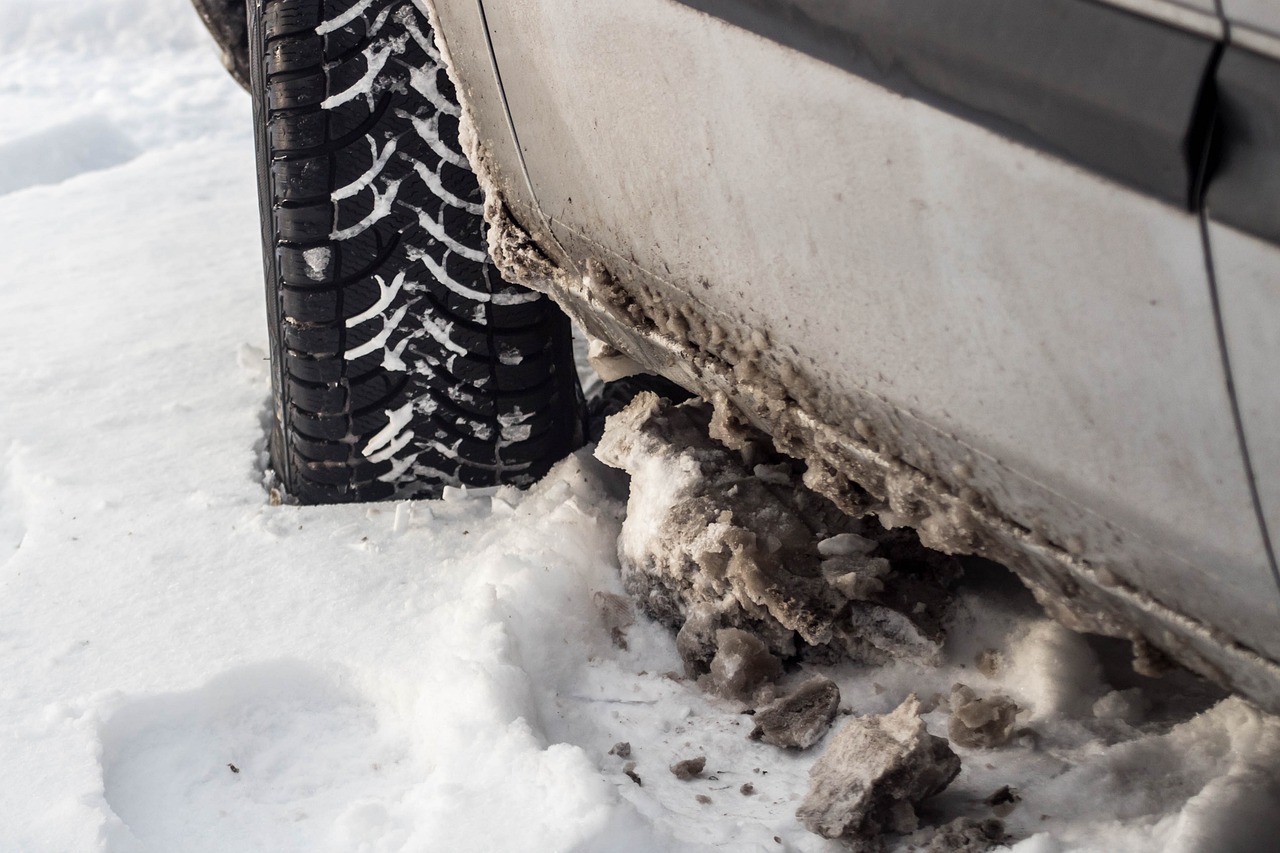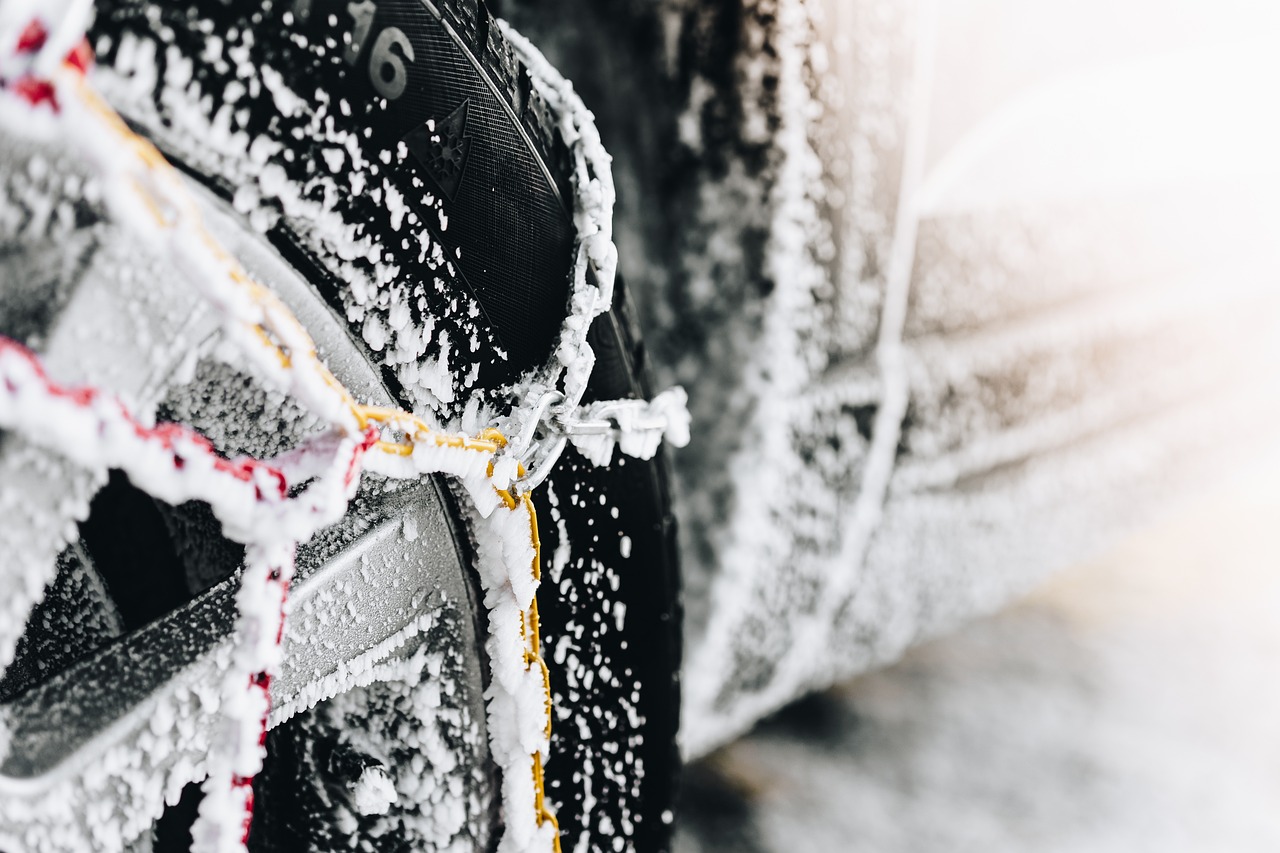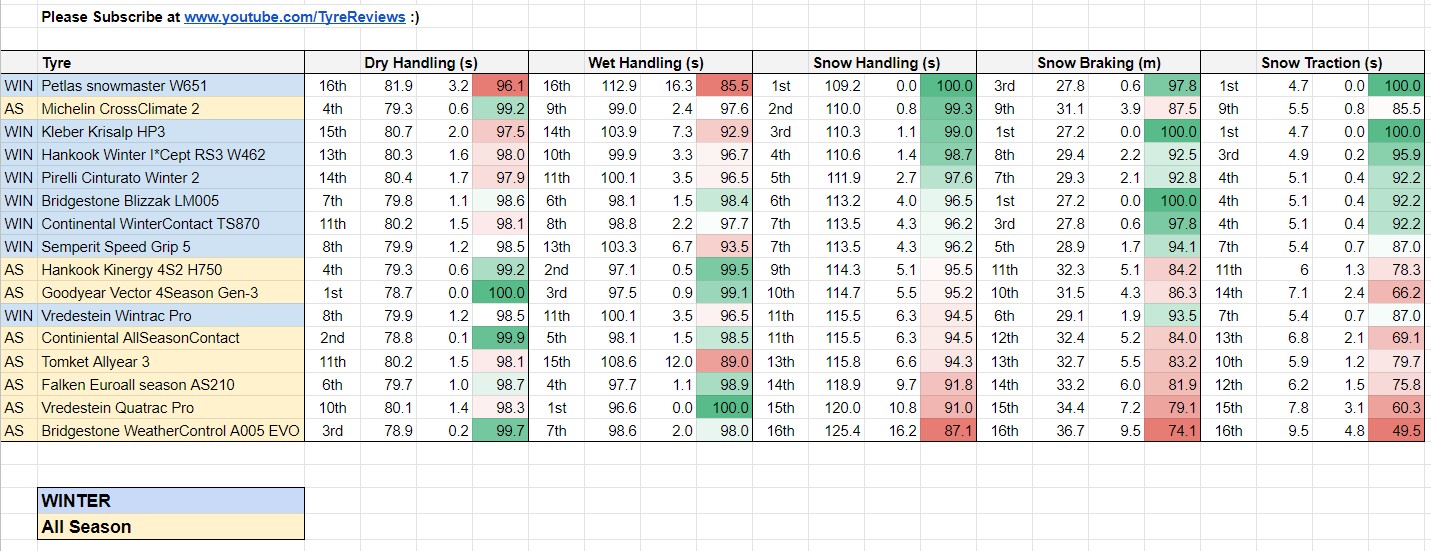Winter Tires vs All Season [All Weather] Tires – What the Data Tells Us
Hello readers of the car blog wheelstrends.com
From today, we will publish articles more regularly every Sunday.
We share real value videos of car usage from famous channels.
We, do not rewrite their content, we narrate it in writing, for those who are not convenient to watch the video, can read.
Hope, readers will love to support and share with your friends.Enter your text here...
Winter Tires vs All Season
In this video, we'll be comparing the performance differences of all season and winter tides in the dry, wet and snow. If you've watched my recent all season and winter tire test, you should now already know what the best all season and the best winter tires are this year. But if you have any questions, feel free to ask below. Many of you are asking me to directly compare compare all season and winter tires. And more than a few of you have noticed that this year I tested all seasonal winter tires at the same time, in the same size, using the same car.

Source: https://pixabay.com/
This has understandably led some of you to start comparing the results. But unfortunately, tire testing is complicated, especially snow. And while the all season and winter tires were tested in the same week, they were tested on different days with quite a lot of temperature difference, which changes the grip of snow a huge amount. It's really actually quite surprising. Fortunately, I planned for these questions in advance, so I ran a common tie between the day so I could calculate the grip and the time changes due to the weather.
But also I'm not the only tester of run all season and winter ties in the same test this year, so I'll be pulling data from multiple sources just so I know we're all on the same page. We're going to be comparing the type of ties Europeans called all season ties and Americans called allweather ties. The best known of these is of course, the Michelin cross climate too. But there are plenty of others, such as the Restoring Quadratic Pro and some time manufacturers have regionspecific tires like the Breechtone Weather Peak and the Breaststown Weather Control AW five Evo. The winter tires will be comparing to what Europeans just call winter tires and Americans tend to call performance winter tires, and that includes tires like the Michelin Pilot Album Five.
If this confuses you, the other category of winter tires stubborn snow ties, like this Michelin XIs. Now I just have in the garage. I'm using it as a prop. Americans generally just call these winter tires, but in Europe they known as studders frictional Nordic tires. As this type of tire is so far ahead of an all season tire in the snow and so far behind the drying wet, it doesn't need a huge amount of discussion.
But do make sure you subscribe internal alerts, as I have a video coming up comparing the Michelin Pilot Sport Four s the Michelin Pilot Sport all season Four the Michelin Cross Climate Two and the Michelin XIs Snow to show you exactly where they all sit. It's actually a really interesting piece of content. This video's sponsor is NordVPN. If you're a regular viewer of the channel, you'll know I live between the USA and Europe and spend my life working from airports, coffee shops, train stations, basically anywhere I can get online. NordVPN helps me do all this securely by encrypting all of my Internet traffic wherever I am, meaning I can be confident that my work and therefore my life won't be compromised.
Not only does NordVPN keep me secure, it also allows me to set my Internet access point to anywhere in the world, meaning I can get access to georestricted services like TV streaming, even if I'm traveling outside of the region. NordVPN is independently tested to be the fastest VPN available, and it uses distiller servers, so it stores nothing about your usage. If you want to protect your Internet, get an exclusive deal of the URL on screen and it's linked in the description it's whiskey with North's 30 day money back guarantee. So how should the all season winter ties behave in theory? Well, when all season ties were first produced in Europe, they were often simply winter tires with slightly less treadmill, which is kind of cheating.
But over the past five years, the category has had plenty of development, and brands are now producing specific all season tire compounds, constructions and tread patterns. Even with all this work, it's important to remember there's no such thing as the perfect tire. No one tire can be the best in the dry weather and the snow, so tire manufacturers have to pick the balance of the three they believe is best. This means all season tires can vary quite a lot in terms of grip on different services. For example, the Michelin Cross Climate Two is known as being the very best all season tire and dry braking and in the snow.

Source: https://pixabay.com/
But it isn't the strongest in the wet. And on the flip side, you have a tire like the Goodyear Vector Four season Generation Three, which excels in the wet but has significantly lower grip than the Michelin and dry. Everything is a balance. My test data is in a 17 inch wheel size, starting with the slow performance of the tires in my test. As I've already said, I did run a control tire between the two days, but as there was over a 3 seconds lap difference between the two days and snow grip revolves throughout a single day, which we have to calculate constantly.
This comparison isn't as accurate as I'd want. Basically, I wouldn't put my name to this as a full test, but the trends are interesting and are exactly as you would expect. In the slow handling test, the eight winter tides on comparing filled seven of the top eight spots. What was your season tie causing the upset? It was, of course, the Michelin Cross Climate Two, which actually came second fastest overall, which is crazy.
There must have been something about the snow handling conditions that really work for this tire. As we know, it's the best all season tire in the snow, but it shouldn't be baiting this many for winter tires. Fortunately for the winter tires, they took back the lead in snow traction and snow braking test. Yes, the Michelin was still the best of the allseason tires, but it was around 15% off the best winter tire in traction and 12% in braking. This is where a winter tire really does make the difference.
Looking at the wet and dry performance, things were predictably reversed, with the all season tires taking seven of the top eight wet spots and the same in the dry. But it was closer than in the snow. The British Stone Blizzard LM five, which actually won my winter test overall, was the best winter tire in both the dry and the wet. Basically, in dry wet handling, a good winter tire is only one or 2% behind a good all season. But in the snow, ignoring the Michelin, a good all season tire is five to 10% behind the winter tire.
I didn't test ice, but I would imagine the gap to be larger than in snow. I'll share the spreadsheet I've just displayed in the description. Sadly, due to testing issues I've gone into elsewhere, I didn't get the chance to cross benchmark drone wet braking. But there are people who have. My favorite nonmetal all season tire test this year was performed by the German magazine Sport Auto.
Not only did they name the winter tire they included, which was the British owned Zak LM five we've already talked about. They also included the excellent BridgeStone Pretend to Sport Summitar. And it was all done in the large 19 inch performance tire size using a sporty Hyundai I 30 m. This means we can see exactly how seven of the best offseason tires compare against some of the best summer and winter tires. And yes, there were only nine sets of tires in total, meaning all the testing was done on the same day.
Once again, in the snow, the Michelin Cross Climate two was the only all season tire that got close to the winter tire and braking, handling, and the slalom. Predictably, the summer tire was completely useless. Where the winter tire had the car stopped from 30 miles an hour and 26 1 meter. The cross time at two was just 26 3 meters, and the summertime was 56 8 meters. Think about that.

Source: https://www.youtube.com/watch?v=8K8ThRGNaoM
It's back to that. Oh my God, that's a big accident. So again, summertime is useless in the snow. We know this dry braking was predictably a walk in the park for the summertime. With the Michelin cross climate to being the best of the all season tires by quite a margin, the Bridge Stone winter tire only managed to beat one of the all season tires.
And it was a similar story in dry handling. Wet testing was more interesting. The magazine conducted the wet test around eight degrees centigrade, or 46 degrees Fahrenheit, which is very close to the industry crossover point of a winter and summer tire. And now it's probably a good tire to remind you that in my experience at least, the Bridgestonee pretends to sport summer tire used in this test is one of the tires that takes the biggest grip penalty. When it's cold, it really does like heat.
That and the British Dome Blizzard LM five winter tie is a bit of a specialist in the wet. It's usually one of the very best winter tires in the dry and wet. In wet braking at eight degrees centigrade, only one all season tie could beat the winter tire, and only two season tires could beat the summer tie. The rest fell behind. Like in wet braking, only one all season tire could beat the winter tire and wet handling.
But the summer tire did drop down. The Order Aqua Lady had just one all season tire ahead of the summer tire, and the winter tire finished in the middle of the group. The magazine also compared noise and rolling resistance. The summer tie was the loudest, and the summer tire had the highest rolling resistance. But this might be more of a feature of the Bridge Stone pretends to sport because of summer tires.
It is generally one of the noisier ones and has a higher rolling resistance. One thing the data doesn't show us is subjective handling. In my experience, an all season tire feels way more like a winter tire in steering, response and feedback. Even the Michelin Cross climate two is still a step behind the summer tire and sportiness. So if you enjoy driving like I do, or have a sporty tire size like the 19 inch in this test, you're going to want to keep a summer tire on for as long as possible.
Finally, let's look at the 2022 auto built off season tire test. As with previous tests, they also included the summer and winter reference tire, but sadly, they didn't name the tires. It's reasonable to assume that they are premium tires, but we don't know what they also tested on a smaller 16 inch wheel size. Again, the wintertime was the best in two of the three snow tests, with the Michelin cross climate two just beating the winter in snow traction, the wintertime had the least grip in the drive, with the summer tire still having a significant advantage. And in the wet, the winter tie finished in the top third of the results.
But the summer tire had a big advantage in wet braking and wet handling in this test. The summer and winter tire also didn't do great in rolling resistance. That was led by the all season tires and the summer tires. Once again, the noises. Maybe it's just not the pretense of sport.
So what does all this data teach us? One, all season and winter tires are currently much closer in overall performance and feel than summer and all season tires. Two, if you live in an area that sees a warm summer and a cold winter, the optimal way of motoring is still two sets of tires. Sorry, it just is. You can't get close to a summer tire in the dry and often the wet, especially in sporty.
Applications, and the winter tire has the advantage in the snow. Having said that, modern all season tires are excellent at what they're trying to do, and they're getting better all the time. Three. As I've said before, using an all season tire as a winter tire for milder regions makes a lot of sense if you live somewhere like the UK and you experience a lot more drying wet running over winter. An all season tire as a winter tire makes a lot of sense to me, as you'll still be fine in a few days of snow running you might experience, but you'll be better off overall than the dry and wet.
Source: https://www.youtube.com/watch?v=8K8ThRGNaoM
